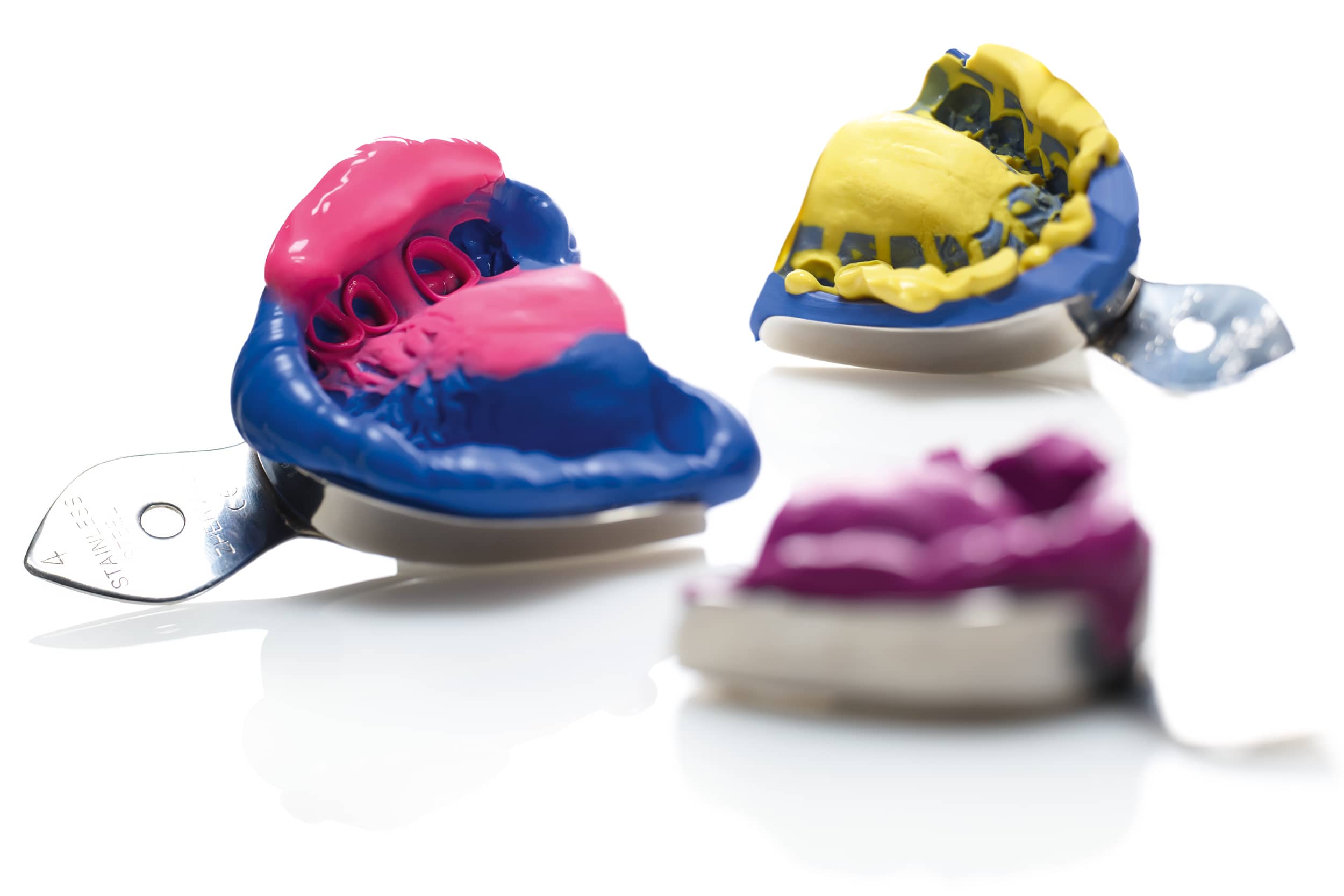
Succeeding in obtaining a prefect impression is perhaps one of the most complex challenges facing dentists, especially when taking impressions on patients with fixed restorations (1).
It is interesting to note that a fairly high percentage of the impressions that leave dental practices and are delivered to dental laboratory benches have obvious flaws (2-4).
The severity of these flaws can vary, but some of them are considered critical.
One critical flaw is any defect along the preparation margin of the impression, be it a void, a bubble or warping (4). A flaw can therefore be defined critical when it can have an adverse effect on the quality and therefore the prognosis of a future restoration.
But what are the main flaws to be avoided when taking impressions (1-4)?
1) Incomplete recording of the margins
This is a critical flaw and can be caused by various factors:
- incorrect gingival margin retraction;
- presence of blood or saliva along the preparation margin;
- failure to comply with the timing recommended by the manufacturer.
When taking impressions it is therefore essential to work in a clean field that is free from contamination by blood and saliva, and with the gingival tissues properly retracted.
There are various methods for gingival retraction (5,6), but they all share the common aim of displacing the tissues in a non-traumatic manner, in order to allow the impression material to reach the margin to be recorded with a sufficient thickness to avoid tears.
This calls for impression materials with high tear resistance, in other words those able to withstand stress even when they have a limited thickness, as in the case of preparation margins.
2) Impression material that does not cure properly
This can be the result of errors during the mixing phase.
During this phase, it is important to:
- observe the indicated doses;
- use the right mixing accessories (tips, measuring spoons, etc.);
- level off the two components when using automatic or semiautomatic mixers, by discarding the initial part of the mixed material.
Otherwise, it may be caused by the inhibition of the curing of the impression material due to contamination by other types of materials used in dentistry.
A classic example is the inhibition of the curing of addition silicones, which occurs when the material is mixed using latex gloves (7).
Inhibition may also be caused by certain astringent/haemostatic liquids, such as aluminium sulphate, which can affect the curing of addition silicones, or ferric sulphate and aluminium chloride, which interfere with polyether curing(8).
In this case, it is advisable to rinse the retraction cords well with water, in order to remove the fluids that can inhibit the curing of the impression material.
Want to find out more?
Find out how to take dental impressions properly
Great care must be paid also to the uncured layer of acrylic resins, which can remain attached to the tooth stump and interfere with the impression material (9).
Before taking the final impression, it is important to clean the tooth stump properly using an alcohol-based product to remove any uncured resin or bonding agent residues.
3) Presence of voids along the margin
This problem can have several causes.
The presence of blood and saliva along the margin can result in the formation of voids; therefore, it is necessary to check for any contamination.
Another common cause is the improper application of the wash material using an intraoral tip.
When dispensing the material on to the preparation, the extremity of the intraoral tip must stay sunk into the impression material, moving in a circular manner over the margin and working up the stump without taking the tip out of the impression material, to avoid introducing air bubbles.
Air bubbles can form if, when using semi-automatic mixers, the material is not levelled off and the initial part discarded.
4) Impression warping
Warping is a common flaw in impressions. It is usually caused by sub-optimum stability of the impression tray inside the patient’s oral cavity during the curing reaction.
Once the impression tray has been introduced into the patient’s mouth, it must be held perfectly still while the material starts to exert its elastic properties, which start to change within the first minute after dispensing (10).
To reduce the risk of warping it is essential to comply with the timing indicated by the manufacturer and opt for materials with a snap-set effect (11). The latter is given by the steepness of the curing curve: usually, the faster the reaction, the shorter the time in which the material offers a certain degree of plastic deformation and thus the likelihood of warping is reduced (12).
To reduce warping, it is also necessary to choose a rigid impression tray of the right size for the patient’s arch, and to for it to be removed along the axis of the tooth.
For fixed restorations, when non-perforated trays are used, it is essential to apply a bonding agent to the impression material-impression tray interface, in order to prevent separation or potential warping.
5) Absence of bonding between the light material and the tray material
This type of flaw can be the result of failure to comply with the working times recommended by the manufacturer or, when using a two-phase technique, it may be caused by improper drying of the preliminary impression.
Contamination of the preliminary impression can also prevent the wash material from adhering properly to the denser material. Moreover, handling the preliminary impression using latex gloves can inhibit curing and therefore prevent the materials from bonding.
Solutions for precision impressions
Zhermack offers several solutions for precision impressions, one of which is Hydrorise System: a range of high-performance addition silicones for impressions on implants and natural tooth stumps.
Formulated for professionals seeking excellent technical characteristics, Hydrorise System is Zhermack’s top-of-the-range product and offers an extensive array of solutions for all clinical situations.
Hydrorise is a highly hydrocompatible silicone that achieves an accuracy of 5 microns in detail reproduction.
References
- Sulaiman,T., Lawson, N. (2019). Diagnosing a Failed Impression: Common Errors and How to Overcome Them. Compendium, 40(3).
- Al-Odinee, N. M., Al-Hamzi, M., Al-Shami, I. Z., Madfa, A., Al-Kholani, A. I., & Al-Olofi, Y. M. (2020). Evaluation of the quality of fixed prosthesis impressions in private laboratories in a sample from Yemen. BMC Oral Health, 20, 1-9.
- Samet, N., Shohat, M., Livny, A., & Weiss, E. I. (2005). A clinical evaluation of fixed partial denture impressions. The Journal of prosthetic dentistry, 94(2), 112-117.
- Rau, C. T., Olafsson, V. G., Delgado, A. J., Ritter, A. V., & Donovan, T. E. (2017). The quality of fixed prosthodontic impressions: An assessment of crown and bridge impressions received at commercial laboratories. The Journal of the American Dental Association, 148(9), 654-660.
- Ahmed, S. N., & Donovan, T. E. (2015). Gingival displacement: Survey results of dentists’ practice procedures. The Journal of prosthetic dentistry, 114(1), 81-85.
- Prasad, K. D., Hegde, C., Agrawal, G., & Shetty, M. (2011). Gingival displacement in prosthodontics: A critical review of existing methods. Journal of interdisciplinary dentistry, 1(2), 80.
- Reitz, C. D., & Clark, N. P. (1988). The setting of vinyl polysiloxane and condensation silicone putties when mixed with gloved hands. The Journal of the American Dental Association, 116(3), 371-375.
- Gherlone E. L’impronta in protesi dentaria. Masson, 2005. n.d.
- Al-Rabab’ah, M. A., Hatamleh, M. M., Al-Tarawneh, S., El-Ma’aita, A., Tahun, I. A., & Jalham, I. S. (2021). Effect of freshly placed core buildup composites on setting of silicon impression materials. The Journal of the Indian Prosthodontic Society, 21(2), 186.
- Lawson NC, Cakir D, Ramp L, Burgess JO. Flow profi le of regular and fast-setting elastomericimpression materials using a shark fi n testing device. J Esthet Restor Dent . 2011;23(3):171-176.
- https://www.styleitaliano.org/snap-set-technology-in-the-vps-impressions-materials/
- Hamalian, T. A., Nasr, E., & Chidiac, J. J. (2011). Impression materials in fixed prosthodontics: influence of choice on clinical procedure. Journal of Prosthodontics: Implant, Esthetic and Reconstructive Dentistry, 20(2), 153-160.
Do you want more information on Zhermack Dental products and solutions?
Contact us

 Zhermack SpA has been one of the most important producers and international distributors of alginates, gypsums and silicone compounds for the dental sector for over 40 years. It has also developed solutions for the industrial and wellbeing sectors.
Zhermack SpA - Via Bovazecchino, 100 - 45021 Badia Polesine (RO), Italy.
Zhermack SpA has been one of the most important producers and international distributors of alginates, gypsums and silicone compounds for the dental sector for over 40 years. It has also developed solutions for the industrial and wellbeing sectors.
Zhermack SpA - Via Bovazecchino, 100 - 45021 Badia Polesine (RO), Italy.


